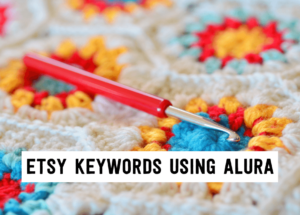
How to find the best Etsy keywords in 3 simple steps using Alura
If you want to be found in search results on Etsy, you need to optimize your product listing for SEO. And if you want to
join
join
It’s no secret that you need good product photos to sell your handmade products— but sometimes it’s not so clear what actually makes a product photo good.
Are there specific details that make one photo better than another? And what kind of photos actually increase the sales of your products?
These are really good questions, and today we are going to talk about 2 of the most important things that you can do in your product photos to increase your sales.
So, ready? Let’s dive in.
First, I want you to know that this article will not be about photo tips— we won’t be talking about things like lighting, or how to take professional photographs and edit them properly.
That is something I’m assuming you’ve already learned, but if you haven’t, I have a very helpful Handmade Photography Getting Started Guide that will teach you all of these details!
Today we’re going to dive deeper into what your photos need to do for your shop, and how to plan for pictures that are actually going to help you convert your views into sales.

free “Beyond etsy” training!
Discover how to make a full-time income and future-proof your business without spending every waking hour on social media, or having to rely on Etsy’s ever-changing platform.
Believe it or not, your photos aren’t just about showing the product, although – of course – they also do need to do that!
But they’re also about triggering the right emotions when your customer sees them, communicating the key pieces of information that your potential customers need, and answering any questions they might have.
The key to getting more sales from your product photos is to think about each photo as if it’s a product description—
you actually want to assume that people WON’T read the product description.
Too many sellers rely on what they say in the product description to sell their product, which can be a problem for multiple reasons:
So instead of thinking of your photos as complementing your product description, think of your product description complementing your photos!
Your photos need to sell the product— they need to convince the buyer that your product is the one they want, and then later when the buyer is really ready to purchase, they might go and read the product description for extra information.
Which brings us to the 2 very important things your product photos must do:
How are you going to do that?
Well, there are two main experiences you want to give your customer through your photos, and we’re going to look at examples for each.
At the most basic level, your photos need to showcase your product.
But it’s not just about showing your product, it is showing your product while creating a feeling.
You want the shopper to picture themselves using your product, seeing it in their lives or in their home, making an emotional connection with the idea of owning that product.
Or if they are shopping for a gift, your photos need to help them picture the gift recipient using and loving the product.
Your photos need to make them feel something. Think of the well-known saying
“I feel, therefore I buy.”
This statement has been proven by stacks of data and research, that our emotional brain is really what drives our purchases.
So . . . how are you going to trigger emotions with your photos?
Well, you’re going to do it the same way that you do when you write a product description.
You may have heard before that you don’t want to just list a bunch of features that your products have in your descriptions . . . you want to turn those features into benefits, right?
Well, your pictures need to do the same – they need to show the benefits of using your products.
The benefits can be something practical, like decluttering or organizing your house. So if you sell organizer boxes, your customer will have less clutter in their house, and that’s a practical benefit.
The benefit can also be something that doesn’t necessarily have a practical value, but instead provides an emotional or a feeling – which is the case for many of you. Maybe it’s something that makes your shopper feel confident, strong, or pretty, or maybe it makes them feel like their house is cozy, welcoming, warm, or stylish.
So how are you going to create those emotions in your pictures?
Well, there are a few things that you can do, let’s look at a couple of examples together.
First let’s look at this picture of some really clever drawer dividers.
In this photo you don’t really see the product all that well – what you’re seeing is the actual dresser, the rug, the hand, and all the little clothes in the divider. So it’s not like a zoom in on the actual product that you’re getting. . .
. . . but you see what it helps ACHIEVE— which is much much more important!
You see a less cluttered drawer for your kid’s bedroom or whatever it is that you’re organizing. And you feel less overwhelm and more peace – you can literally feel the satisfaction you would feel if you opened that drawer.
This experience is something you can replicate in the photos you take for anything you sell.
I often hear from sellers who sell decor items or art, saying “my product doesn’t have any benefit. It’s just pretty, there is no “purpose,” so how do I sell that in the photos?”
So now I want to look at a second example in which the product doesn’t have a practical function but is more something you would buy because it’s pretty or looks good.
In cases like this, you really want to tap into using lifestyle images and props around your products instead of just a plain background or white background.
You cannot sell successfully and keep beating your competition if you don’t invest in lifestyle props and models and use them to create your photos; everyone is doing it and now customers expect it.
You will use lifestyle images to recreate an emotion and help the potential customer picture themselves feeling a certain way and the product fitting into their lives or the life that they want to have.
Let’s take a look at this example of a listing for a pretty plant basket.
I want you to notice all the things in this picture that don’t come with this basket when you buy it:
There are these super healthy plants (that look so much better than mine!), the couch behind with the beautiful assortment of multicolored pillows, the super cute little table and the lovely ray of soft sunshine that’s hitting the plant just right . . . all of these details create a feeling when you look at the photo.
The feeling doesn’t come with what you’re buying. . . but what you’re buying is the opportunity to create this same feeling in your house. Because if you buy this and put it in your living room, you can create a similar experience for you and your guests when you have people visit your house.
If your photo accurately represents what your ideal customer wants their house to look like, you’re actually selling them the vibe of the room in your picture and the feeling someone gets when they are in the room – even though you’re just selling them this one plant basket.
The same is true for art pieces, wall hangings, and really any product in the art or decoration niche. It might not have a practical purpose other than being pretty and making people feel at home . . . but that’s a huge emotion you need to tap into by using the correct props, mockups, the correct styling on your images— all of those details!
You need to remember that you aren’t just selling home decor, you’re selling how the decor will make their house feel
Whatever you are selling, the questions you want to ask yourself are
. . . and then you want to reproduce that with lifestyle photos, props that you use around your item, etc.
Once you’ve hooked the potential customer and “ticked the box” of triggering their emotions, the second step is to simplify the decision process for them.
This is about answering questions that your potential customers might have and communicating key features of your product— and it’s something that way too many sellers only do in the product descriptions
Remember— we’re imagining that they’re not going to read the product description, and so you’re asking yourself what is the most important information that you need to communicate with your pictures to potential customers.
One way to do this is to look at your product description and highlight the parts that might be helpful to explain visually in your pictures, such as key features of your product or processes that might be a little confusing.
Remember, your photos don’t have to only be product photos, you can mix photos, photos with notes and arrows highlighting certain product features, as well as graphics that illustrate important details.
Let’s look at a few examples together:
The first example is an adorable nursery decor product.
Now when you first see this product, you might be wondering “which animals can I choose from?” And, “Can I add any name I want?”
And then you might also want to know, “How does it work? Am I going to need batteries? Or will it plug that into the wall?” — questions about how it is actually going to work.
And instead of leaving that information in the description, the seller helps you by creating these graphics mixed with photos.
The first picture clearly shows you that you can choose 6 different animal designs for your night light, and then it shows you where the personalized baby’s name would be added.
It’s visually telling you things that would actually be really hard to say with words in your print description. Plus, it’s branded and it’s cute! So it keeps triggering all the right emotions, but also serves the function of conveying important information from the product description.
This next picture shows you the back of the clock. Now of course no one goes through the product pictures to look at it from the back – like no one really cares about what it looks like from behind!
But what this does is show you the power options, so the shopper who sees this will be thinking “hey – cool – I can use a battery, or I can use a micro USB cable!” . . . so they know that they have those two options to power the night light.
The next photo is literally answering the question “what’s in the box?”
So you see that it does come with the actual micro USB cable, which is especially handy if it’s a gift because you don’t have to worry about the recipient not being able to use it when they open it.
You also see in this picture that it comes with a cute little card that can be sent to the receiver directly. So this is telling you a lot of things that you then don’t really need to read again in the product description.
Photos can also be used to simplify a process: let’s look at a couple of order process examples.
Here is a photo from a listing for personalized gift boxes.
When you are deciding what you need for your photos, you also want to be mindful of situations where the order requires a few steps, and how you are going to make that super clear to your shoppers.
In this example the product being sold is a build your own gift box – you get to pick the items that go into it. And so there’s a process involved in ordering, and you can lose people – as in lose customers – if it’s not super clear how they choose options and place the order.
This graphic does a really nice job because it tells you exactly how the order process works.
As you can see this is not a photo, it is just a graphic uploaded as a photo.
The process is very clear: first you personalize your card and choose a base gift box, second you add items to the cart that you want the gift box to contain, and then you check out.
If you look in the product description, it is very short and essentially says the same thing that I’ve seen in a picture, so it nicely complements what the pictures already told you and makes you confident as a customer that oh, okay, this is pretty clear and straightforward. I’m not getting lost in the ordering process.
And it’s done in a way that is easy for me to read and understand, even before I’ve read the product description.
So you can see that using photos and graphics can really simplify the ordering process for your customers.
Now you probably have different products than necklaces or night lights, and you’re wondering – how can you determine what information you need to convey to your shoppers in your product photos?
The best way to figure that out is to reverse engineer the process.
You don’t want to just take pictures then hope that they have all the right information, feelings, and emotions needed to sell your products. You want to first start away from your camera and write down what kinds of information your customer is going to need.
Ask yourself:
You want to list anything you can think of that might create doubt or confusion in the customer’s mind and get in the way of the purchase decision, because if you leave them with any kind of doubt about the product or the ordering process they’re not going to check out.
So what kinds of things can cause doubt? It’s little things like
These are the little questions that you need to answer with your photos, so add them to the list you’re making.
Next go to your product descriptions and highlight the most important parts, and write that down on that list as well.
Then you look at that list and come up with a plan to answer those questions using photos and graphics. Don’t forget that your photos can use graphics as well, they’re super handy and you should totally be using them. You can have a picture that’s actually just a graphic as we’ve seen in the example, or you can use text on your photos to point at things with cute little arrows to show size and add information to your product photos.
Your goal is to answer questions and to make the purchase decision really easy for your customer— you want them to feel confident that they’re getting what they think they’re getting, that’s what your pictures really need to do.
In the next few weeks we are going to be talking about even more photo tips and secrets – including how to pick props for your product photos and how to tell when your products photos need a refresh.
Now you may want to dive deeper into how to take product photos that bring more customers to your shop and make more sales 💰 – be sure to check out Tizzit HQ – we have SO many courses and workshops to help you do just that inside the HQ, such as:

e-com sales on tap training
simple step-by-step plan to grow your online store sales into a consistent and predictable income with the Reliable eCom Sales System
Thanks for reading and until next time, au revoir!
you might also like…
related articles

If you want to be found in search results on Etsy, you need to optimize your product listing for SEO. And if you want to
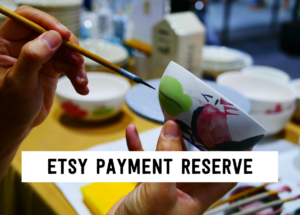
There has been a lot of talk in the Etsy community — and I mean A LOT of talk — about Etsy’s payment account reserve
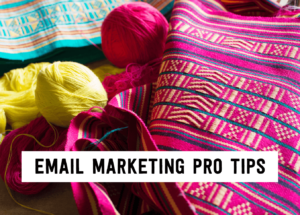
Anyone who knows me knows that I am a HUGE advocate for using email marketing to grow and scale your handmade business. But you may
disclaimer
subscribe to youtube
THE LAUNCHPAD
get in touch
We acknowledge and give thanks to the Budawang and Yuin people, the Traditional Owners of the land we work and live on. We pay our respects to all Aboriginal and Torres Strait Islander Peoples and elders past, present and emerging.
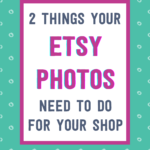
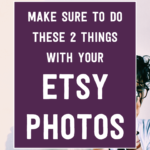

Learn how to grow your business beyond etsy as easily as possible

learn how to grow your online store sales into a consistent and predictable income
Hi Deb,
this article is so helpful as well as your entire step- by-step course! I`ve learned so much from you! THANK YOU!
Hello Yanita. Thank you for your kind words. We are very glad that our courses are helpful to you.